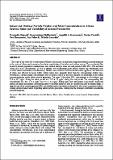Por favor, use este identificador para citar o enlazar a este item:
http://hdl.handle.net/10261/344637COMPARTIR / EXPORTAR:
 SHARE SHARE
 CORE
BASE CORE
BASE
|
|
| Visualizar otros formatos: MARC | Dublin Core | RDF | ORE | MODS | METS | DIDL | DATACITE | |

| Título: | Indoor and outdoor particle number and mass concentrations in Athens. Sources, sinks and variability of aerosol parameters |
Autor: | Diapouli, Evangelia; Eleftheriadis, Konstantinos; Karanasiou, Angeliki CSIC ORCID ; Vratolis, Sterios; Hermansen, Ove; Colbeck, Ian; Lazaridis, Mihalis | Palabras clave: | Residential microenvironment Black carbon Indoor/outdoor sources Particle number size distribution PM /PM 10 2 |
Fecha de publicación: | 1-nov-2011 | Editor: | Gigvvy Science | Citación: | Aerosol and Air Quality Research 11: 632-642 (2011) | Resumen: | The scope of this work was to characterize PM mass and number concentration at typical residential microenvironments in the centre of Athens and to examine the relative contribution of the indoor and outdoor sources. Three residential flats located in densely populated residential areas were studied, during a warm and cold period of 2002. PM 10, PM 2 and black carbon (BC) mass concentrations, as well as ultrafine and accumulation mode particle number size distributions were recorded indoors and outdoors simultaneously. Outdoor concentrations of all size fractions were significant, and indicative of urban sites affected by heavy traffic. Indoor levels were generally lower than the corresponding outdoor ones. Nevertheless, elevated indoor concentrations were recorded, caused by increased ambient air penetration in the indoor microenvironments and/or indoor particle generation. The mean 24-hr indoor PM 10 concentration at all residences was 35.0 ± 10.7 μg/m 3 during the warm period and 31.8 ± 7.8 μg/m 3 during the cold period. The corresponding PM 2 concentration was 30.1 ± 11.1 μg/m 3 and 27.2 ± 3.6 μg/m 3 during warm and cold periods, respectively. Regression analysis of indoor and outdoor concentration data revealed that indoor BC may be considered mainly of outdoor origin. A large fraction of the outdoor-generated PM 2 and ultrafine and accumulation mode particles also seems to penetrate indoors, causing elevated indoor levels. Regarding indoor particle generation, cooking was the strongest contributor in residential microenvironments. © Taiwan Association for Aerosol Research. | Versión del editor: | https://doi.org/10.4209/aaqr.2010.09.0080 | URI: | http://hdl.handle.net/10261/344637 | DOI: | 10.4209/aaqr.2010.09.0080 | ISSN: | 16808584 |
| Aparece en las colecciones: | (IDAEA) Artículos |
Ficheros en este ítem:
| Fichero | Descripción | Tamaño | Formato | |
|---|---|---|---|---|
| aaqr-10-09-oa-0080.pdf | Artículo principal | 367,38 kB | Adobe PDF |  Visualizar/Abrir |
CORE Recommender
SCOPUSTM
Citations
65
checked on 23-abr-2024
WEB OF SCIENCETM
Citations
60
checked on 24-feb-2024
Page view(s)
31
checked on 30-abr-2024
Download(s)
8
checked on 30-abr-2024
Google ScholarTM
Check
Altmetric
Altmetric
NOTA: Los ítems de Digital.CSIC están protegidos por copyright, con todos los derechos reservados, a menos que se indique lo contrario.


